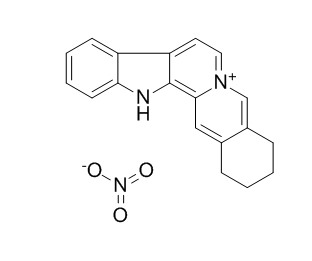Sempervirine nitrate
Sempervirine nitrate , a specific molecular inhibitor of Mdm2, to MEF cells abrogated Period 2 ubiquitination leading to the accumulation of a stable pool of Period 2.
Inquire / Order:
manager@chemfaces.com
Technical Inquiries:
service@chemfaces.com
Tel:
+86-27-84237783
Fax:
+86-27-84254680
Address:
1 Building, No. 83, CheCheng Rd., Wuhan Economic and Technological Development Zone, Wuhan, Hubei 430056, PRC
Providing storage is as stated on the product vial and the vial is kept tightly sealed, the product can be stored for up to
24 months(2-8C).
Wherever possible, you should prepare and use solutions on the same day. However, if you need to make up stock solutions in advance, we recommend that you store the solution as aliquots in tightly sealed vials at -20C. Generally, these will be useable for up to two weeks. Before use, and prior to opening the vial we recommend that you allow your product to equilibrate to room temperature for at least 1 hour.
Need more advice on solubility, usage and handling? Please email to: service@chemfaces.com
The packaging of the product may have turned upside down during transportation, resulting in the natural compounds adhering to the neck or cap of the vial. take the vial out of its packaging and gently shake to let the compounds fall to the bottom of the vial. for liquid products, centrifuge at 200-500 RPM to gather the liquid at the bottom of the vial. try to avoid loss or contamination during handling.
Food Chem.2022, 373(Pt B):131364.
Univerzita Karlova2021, 20.500.11956.
J Pharm Anal.2016, 6(6):363-373
Nutrients.2022, 14(19):4170.
Appl. Sci. 2021, 11(8),3437.
Clin Transl Oncol.2019, 10.1007
Journal of Functional Foods2024, 116:106186
Phytother Res.2022, 10.1002:ptr.7626.
Indian J Pharm Sci.2024, 86(2):736-741.
Environ Toxicol.2019, 34(12):1354-1362
Related and Featured Products
VTechWorks,2016-06-20
Identification and Regulatory Role of E3 Ligases in the Time-Dependent Degradation of the Circadian Factor Period 2.[Reference:
WebLink]
Circadian rhythms are self-sustained, 24h, biological oscillatory processes that are present in organisms ranging from bacteria to human. Circadian rhythms, which can be synchronized by external cues, are important for organisms to adjust their behavior, physiological activity, and metabolic reactions to changes in environmental conditions. Another well-established oscillatory mechanism that shares common organizational and regulatory features with the circadian system, is the cell division cycle. Recent findings reveal that some essential regulators are common to both the cell cycle and the circadian clock.
METHODS AND RESULTS:
The first half of my thesis (Chapter 2-3) focuses on the function of Period 2 (Per2), a key regulatory component of the negative feedback arm of the clock and tumor suppressor protein, as a modulator of cell cycle response. We found that Per2 binds the C-terminus end of the tumor suppressor p53 thus forming a trimeric complex with p53's negative regulator Mdm2 and preventing Mdm2-mediated p53's ubiquitination and degradation. Thus, Per2 stabilizes p53 under unstressed conditions allowing for basal levels of the protein to exist and be available for a rapid response to take place in case of any stressed signals. Our experiments prove that Per2 plays an indispensible role in p53 signaling pathway.
The second half of my thesis (Chapter 4-5) focuses on how Mdm2 and Per2 interplay regulate Per2 availability and its impact on circadian clock function. My research found that Mdm2 targets Per2 for ubiquitination as Mdm2 depletion stabilizes Per2 and, conversely, Mdm2 ectopic expression shorten Per2's half-life. Accordingly, association of Per2 to Mdm2 maps C-terminus of the p53 binding region in Mdm2 and thus, the RING domain remains accessible. Next, we tested the hypothesis that Mdm2-dependent ubiquitination of Per2 directly impacts circadian clock period length. Accordingly, addition of Sempervirine nitrate (SN), a specific molecular inhibitor of Mdm2, to MEF cells abrogated Per2 ubiquitination leading to the accumulation of a stable pool of Per2. By recording the oscillatory behavior of the Per2:Luc reporter system in MEF cells treated with SN at different circadian times, we found that inhibition of Mdm2 E3 ligase activity promoted phase advance only when treatment took place during the degradation period. This is in agreement with our findings that radiation, but not light pulses, causes the same phase behavior. Considering the established role of both Mdm2 and p53 in the response of cells to genotoxic stress and Per2 in modulating the clock, the existence of the Mdm2-Per2-p53 complex opens the possibility of various stimuli triggering regulatory mechanisms converging in a critical node.
CONCLUSIONS:
Overall, our work provides a holistic view of how signals are integrated at multiple levels to ensure that environmental signals are sense and responses triggered timely.



